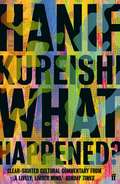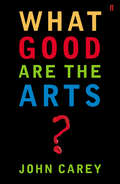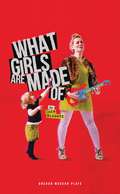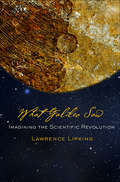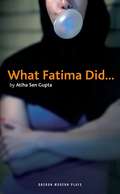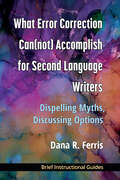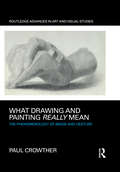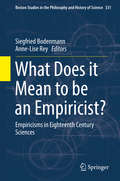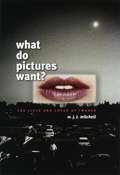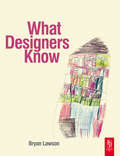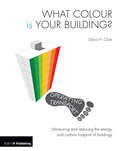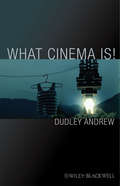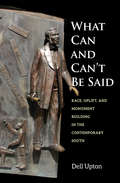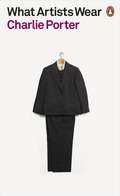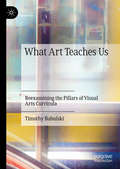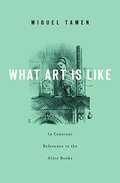- Table View
- List View
What Happened?
by Hanif Kureishi'No one else casts such a shrewd and gimlet eye on contemporary life.' - William Boyd Comic, dark and insightful, What Happened? is Hanif Kureishi's new collection of essays and fiction. No topic is too fringe or too mainstream for this insatiable-and much-loved-author. From social media to the ancient classics, from appraisals of David Bowie to Georges Simenon to Keith Jarrett, this is the latest literary 'event' in a unique body of work that displays Kureishi's characteristic boundless curiosity and wit. What Happened? is as much about the very fact of Kureishi's catholic appetite for culture as his observations and insights themselves, and any new book in his oeuvre is a justification for celebration.
What Good are the Arts?
by Professor John CareyFrom one of the country's most eminent reviewers and academics, a delightfully sceptical and devastatingly intelligent assessment of the true value of art.
What Girls Are Made Of (Oberon Modern Plays)
by Cora BissettIt’s 1992. In a small town in Fife, a girl is busting to get out into the world and see what's on offer. And an ad in the local paper declares: BAND SEEKS SINGER.Grunge has just gone global, scruffy indie kids are inheriting the earth, and a schoolgirl from Glenrothes is catapulted to a rock star lifestyle as the singer in a hot new indie band. Touring with Radiohead, partying with Blur, she was living the dream. Until she wasn’t.Based on her meticulously detailed, pull-no-punches teenage diaries, this is the true story of Cora Bissett’s rollercoaster journey from the girl she was to the woman she wanted to be.
What Galileo Saw: Imagining the Scientific Revolution
by Lawrence LipkingThe Scientific Revolution of the seventeenth century has often been called a decisive turning point in human history. It represents, for good or ill, the birth of modern science and modern ways of viewing the world. In What Galileo Saw, Lawrence Lipking offers a new perspective on how to understand what happened then, arguing that artistic imagination and creativity as much as rational thought played a critical role in creating new visions of science and in shaping stories about eye-opening discoveries in cosmology, natural history, engineering, and the life sciences. When Galileo saw the face of the Moon and the moons of Jupiter, Lipking writes, he had to picture a cosmos that could account for them. Kepler thought his geometry could open a window into the mind of God. Francis Bacon's natural history envisioned an order of things that would replace the illusions of language with solid evidence and transform notions of life and death. Descartes designed a hypothetical "Book of Nature" to explain how everything in the universe was constructed. Thomas Browne reconceived the boundaries of truth and error. Robert Hooke, like Leonardo, was both researcher and artist; his schemes illuminate the microscopic and the macrocosmic. And when Isaac Newton imagined nature as a coherent and comprehensive mathematical system, he redefined the goals of science and the meaning of genius. What Galileo Saw bridges the divide between science and art; it brings together Galileo and Milton, Bacon and Shakespeare. Lipking enters the minds and the workshops where the Scientific Revolution was fashioned, drawing on art, literature, and the history of science to reimagine how perceptions about the world and human life could change so drastically, and change forever.
What Fatima Did (Oberon Modern Plays)
by Atiha Sen GuptaFatima Merchant is feisty and strong-willed. At 17, she drinks, smokes and parties. On the eve of her 18th birthday, without word or warning or explanation, she adopts the hijab. Suddenly, to her friends and family she is no longer the Fatima they thought they knew. What Fatima Did... is a funny and provocative exploration of attitudes to identity, freedom and multiculturalism in contemporary London.
What Error Correction Can(not) Accomplish for Second Language Writers: DIspelling Myths, Discussing Options
by Dana R. FerrisThis book looks at aspects of L2 research that influence error correction, finding that second language acquisition takes time and that second language writers' texts differ from those written by native English speakers. Using this research, Dana R. Ferris dispels the myth that diligent teacher correction and student editing can lead to perfect, error-free texts. In clear and simple terms, Ferris makes six suggestions for things teachers can do in the classroom regarding error correction and provides samples. Other issues regarding the expectations of students and others—such as in timed (high-stakes) situations—as it relates to "perfect" papers are examined. The book closes by addressing the basic principles of developing students' language skills in second language/ESL writing classes.
What Drawing and Painting Really Mean: The Phenomenology of Image and Gesture (Routledge Advances in Art and Visual Studies)
by Paul CrowtherThere are as many meanings to drawing and painting as there are cultural contexts for them to exist in. But this is not the end of the story. Drawings and paintings are made, and in their making embody unique meanings that transform our perception of space-time and sense of finitude. These meanings have not been addressed by art history or visual studies hitherto, and have only been considered indirectly by philosophers (mainly in the phenomenological tradition). If these intrinsic meanings are explained and further developed, then the philosophy of art practice is significantly enhanced. The present work, accordingly, is a phenomenology of how the gestural and digital creation of visual imagery generates self-transformation through aesthetic space.
What Drawing and Painting Really Mean: The Phenomenology of Image and Gesture (Routledge Advances in Art and Visual Studies)
by Paul CrowtherThere are as many meanings to drawing and painting as there are cultural contexts for them to exist in. But this is not the end of the story. Drawings and paintings are made, and in their making embody unique meanings that transform our perception of space-time and sense of finitude. These meanings have not been addressed by art history or visual studies hitherto, and have only been considered indirectly by philosophers (mainly in the phenomenological tradition). If these intrinsic meanings are explained and further developed, then the philosophy of art practice is significantly enhanced. The present work, accordingly, is a phenomenology of how the gestural and digital creation of visual imagery generates self-transformation through aesthetic space.
What Does it Mean to be an Empiricist?: Empiricisms in Eighteenth Century Sciences (Boston Studies in the Philosophy and History of Science #331)
by Siegfried Bodenmann Anne-Lise ReyThis book begins with an observation: At the time when empiricism arose and slowly established itself, the word itself had not yet been coined. Hence the central question of this volume: What does it mean to conduct empirical science in early modern Europe? How can we catch the elusive figure of the empiricist?Our answer focuses on the practices established by representative scholars. This approach allows us to demonstrate two things. First, that empiricism is not a monolith but exists in a plurality of forms. Today’s understanding of the empirical sciences was gradually shaped by the exchanges among scholars combining different traditions, world views and experimental settings. Second, the long proclaimed antagonism between empiricism and rationalism is not the whole story. Our case studies show that a very fruitful exchange between both systems of thought occurred. It is a story of integration, appropriation and transformation more than one of mere opposition. We asked twelve authors to explore these fascinating new facets of empiricisms. The plurality of their voices mirrors the multiple faces of the concept itself. Every contribution can be understood as a piece of a much larger puzzle. Together, they help us better understand the emergence of empiricism and the inventiveness of the scientific enterprise.
What Do Pictures Want?: The Lives and Loves of Images
by W. J. MitchellWhy do we have such extraordinarily powerful responses toward the images and pictures we see in everyday life? Why do we behave as if pictures were alive, possessing the power to influence us, to demand things from us, to persuade us, seduce us, or even lead us astray? According to W. J. T. Mitchell, we need to reckon with images not just as inert objects that convey meaning but as animated beings with desires, needs, appetites, demands, and drives of their own. What Do Pictures Want? explores this idea and highlights Mitchell's innovative and profoundly influential thinking on picture theory and the lives and loves of images. Ranging across the visual arts, literature, and mass media, Mitchell applies characteristically brilliant and wry analyses to Byzantine icons and cyberpunk films, racial stereotypes and public monuments, ancient idols and modern clones, offensive images and found objects, American photography and aboriginal painting. Opening new vistas in iconology and the emergent field of visual culture, he also considers the importance of Dolly the Sheep—who, as a clone, fulfills the ancient dream of creating a living image—and the destruction of the World Trade Center on 9/11, which, among other things, signifies a new and virulent form of iconoclasm. What Do Pictures Want? offers an immensely rich and suggestive account of the interplay between the visible and the readable. A work by one of our leading theorists of visual representation, it will be a touchstone for art historians, literary critics, anthropologists, and philosophers alike. “A treasury of episodes—generally overlooked by art history and visual studies—that turn on images that ‘walk by themselves’ and exert their own power over the living.”—Norman Bryson, Artforum
What Do Pictures Want?: The Lives and Loves of Images (Prehistoric Archeology And Ecology Ser.)
by W. J. MitchellWhy do we have such extraordinarily powerful responses toward the images and pictures we see in everyday life? Why do we behave as if pictures were alive, possessing the power to influence us, to demand things from us, to persuade us, seduce us, or even lead us astray? According to W. J. T. Mitchell, we need to reckon with images not just as inert objects that convey meaning but as animated beings with desires, needs, appetites, demands, and drives of their own. What Do Pictures Want? explores this idea and highlights Mitchell's innovative and profoundly influential thinking on picture theory and the lives and loves of images. Ranging across the visual arts, literature, and mass media, Mitchell applies characteristically brilliant and wry analyses to Byzantine icons and cyberpunk films, racial stereotypes and public monuments, ancient idols and modern clones, offensive images and found objects, American photography and aboriginal painting. Opening new vistas in iconology and the emergent field of visual culture, he also considers the importance of Dolly the Sheep—who, as a clone, fulfills the ancient dream of creating a living image—and the destruction of the World Trade Center on 9/11, which, among other things, signifies a new and virulent form of iconoclasm. What Do Pictures Want? offers an immensely rich and suggestive account of the interplay between the visible and the readable. A work by one of our leading theorists of visual representation, it will be a touchstone for art historians, literary critics, anthropologists, and philosophers alike. “A treasury of episodes—generally overlooked by art history and visual studies—that turn on images that ‘walk by themselves’ and exert their own power over the living.”—Norman Bryson, Artforum
What Do Pictures Want?: The Lives and Loves of Images
by W. J. MitchellWhy do we have such extraordinarily powerful responses toward the images and pictures we see in everyday life? Why do we behave as if pictures were alive, possessing the power to influence us, to demand things from us, to persuade us, seduce us, or even lead us astray? According to W. J. T. Mitchell, we need to reckon with images not just as inert objects that convey meaning but as animated beings with desires, needs, appetites, demands, and drives of their own. What Do Pictures Want? explores this idea and highlights Mitchell's innovative and profoundly influential thinking on picture theory and the lives and loves of images. Ranging across the visual arts, literature, and mass media, Mitchell applies characteristically brilliant and wry analyses to Byzantine icons and cyberpunk films, racial stereotypes and public monuments, ancient idols and modern clones, offensive images and found objects, American photography and aboriginal painting. Opening new vistas in iconology and the emergent field of visual culture, he also considers the importance of Dolly the Sheep—who, as a clone, fulfills the ancient dream of creating a living image—and the destruction of the World Trade Center on 9/11, which, among other things, signifies a new and virulent form of iconoclasm. What Do Pictures Want? offers an immensely rich and suggestive account of the interplay between the visible and the readable. A work by one of our leading theorists of visual representation, it will be a touchstone for art historians, literary critics, anthropologists, and philosophers alike. “A treasury of episodes—generally overlooked by art history and visual studies—that turn on images that ‘walk by themselves’ and exert their own power over the living.”—Norman Bryson, Artforum
What Do Pictures Want?: The Lives and Loves of Images
by W. J. MitchellWhy do we have such extraordinarily powerful responses toward the images and pictures we see in everyday life? Why do we behave as if pictures were alive, possessing the power to influence us, to demand things from us, to persuade us, seduce us, or even lead us astray? According to W. J. T. Mitchell, we need to reckon with images not just as inert objects that convey meaning but as animated beings with desires, needs, appetites, demands, and drives of their own. What Do Pictures Want? explores this idea and highlights Mitchell's innovative and profoundly influential thinking on picture theory and the lives and loves of images. Ranging across the visual arts, literature, and mass media, Mitchell applies characteristically brilliant and wry analyses to Byzantine icons and cyberpunk films, racial stereotypes and public monuments, ancient idols and modern clones, offensive images and found objects, American photography and aboriginal painting. Opening new vistas in iconology and the emergent field of visual culture, he also considers the importance of Dolly the Sheep—who, as a clone, fulfills the ancient dream of creating a living image—and the destruction of the World Trade Center on 9/11, which, among other things, signifies a new and virulent form of iconoclasm. What Do Pictures Want? offers an immensely rich and suggestive account of the interplay between the visible and the readable. A work by one of our leading theorists of visual representation, it will be a touchstone for art historians, literary critics, anthropologists, and philosophers alike. “A treasury of episodes—generally overlooked by art history and visual studies—that turn on images that ‘walk by themselves’ and exert their own power over the living.”—Norman Bryson, Artforum
What Do Pictures Want?: The Lives and Loves of Images (Prehistoric Archeology And Ecology Ser.)
by W. J. MitchellWhy do we have such extraordinarily powerful responses toward the images and pictures we see in everyday life? Why do we behave as if pictures were alive, possessing the power to influence us, to demand things from us, to persuade us, seduce us, or even lead us astray? According to W. J. T. Mitchell, we need to reckon with images not just as inert objects that convey meaning but as animated beings with desires, needs, appetites, demands, and drives of their own. What Do Pictures Want? explores this idea and highlights Mitchell's innovative and profoundly influential thinking on picture theory and the lives and loves of images. Ranging across the visual arts, literature, and mass media, Mitchell applies characteristically brilliant and wry analyses to Byzantine icons and cyberpunk films, racial stereotypes and public monuments, ancient idols and modern clones, offensive images and found objects, American photography and aboriginal painting. Opening new vistas in iconology and the emergent field of visual culture, he also considers the importance of Dolly the Sheep—who, as a clone, fulfills the ancient dream of creating a living image—and the destruction of the World Trade Center on 9/11, which, among other things, signifies a new and virulent form of iconoclasm. What Do Pictures Want? offers an immensely rich and suggestive account of the interplay between the visible and the readable. A work by one of our leading theorists of visual representation, it will be a touchstone for art historians, literary critics, anthropologists, and philosophers alike. “A treasury of episodes—generally overlooked by art history and visual studies—that turn on images that ‘walk by themselves’ and exert their own power over the living.”—Norman Bryson, Artforum
What Do Pictures Want?: The Lives and Loves of Images
by W. J. MitchellWhy do we have such extraordinarily powerful responses toward the images and pictures we see in everyday life? Why do we behave as if pictures were alive, possessing the power to influence us, to demand things from us, to persuade us, seduce us, or even lead us astray? According to W. J. T. Mitchell, we need to reckon with images not just as inert objects that convey meaning but as animated beings with desires, needs, appetites, demands, and drives of their own. What Do Pictures Want? explores this idea and highlights Mitchell's innovative and profoundly influential thinking on picture theory and the lives and loves of images. Ranging across the visual arts, literature, and mass media, Mitchell applies characteristically brilliant and wry analyses to Byzantine icons and cyberpunk films, racial stereotypes and public monuments, ancient idols and modern clones, offensive images and found objects, American photography and aboriginal painting. Opening new vistas in iconology and the emergent field of visual culture, he also considers the importance of Dolly the Sheep—who, as a clone, fulfills the ancient dream of creating a living image—and the destruction of the World Trade Center on 9/11, which, among other things, signifies a new and virulent form of iconoclasm. What Do Pictures Want? offers an immensely rich and suggestive account of the interplay between the visible and the readable. A work by one of our leading theorists of visual representation, it will be a touchstone for art historians, literary critics, anthropologists, and philosophers alike. “A treasury of episodes—generally overlooked by art history and visual studies—that turn on images that ‘walk by themselves’ and exert their own power over the living.”—Norman Bryson, Artforum
What Designers Know
by Bryan LawsonEach chapter deals with a different technique from which we can best represent and make explicit the forms of knowledge used by designers. The book explores whether design knowledge is special, and attempts to get to the root of where design knowledge comes from. Crucially, it focuses on how designers use drawings in communicating their ideas and how they ‘converse’ with them as their designs develop. It also shows how experienced designers use knowledge differently to novices suggesting that design ‘expertise’ can be developed. Overall, this book builds a layout of the kinds of skill, knowledge and understanding that make up what we call designing.
What Designers Know
by Bryan LawsonEach chapter deals with a different technique from which we can best represent and make explicit the forms of knowledge used by designers. The book explores whether design knowledge is special, and attempts to get to the root of where design knowledge comes from. Crucially, it focuses on how designers use drawings in communicating their ideas and how they ‘converse’ with them as their designs develop. It also shows how experienced designers use knowledge differently to novices suggesting that design ‘expertise’ can be developed. Overall, this book builds a layout of the kinds of skill, knowledge and understanding that make up what we call designing.
What Colour is your Building?: Measuring and reducing the energy and carbon footprint of buildings
by David ClarkDefining and reducing the carbon footprint of a new or refurbished building can be a daunting task. There are lots of tools to measure the environmental impact of buildings, but they all measure energy and CO2 in different ways, and they do not measure the whole carbon footprint. What Colour is your Building? provides practical and pragmatic guidance on how to calculate and then compare the whole carbon footprint of buildings using one simple method looking at operating, embodied and transport energy. It will equip designers, building owners, occupiers, planners and policy makers with the tools and knowledge that they will need to make decisions early on about where the big impacts will be in terms of reducing the carbon footprint of the building, including: A new, simple approach to understanding the whole carbon impact of buildings Benchmarking data for operating energy performance A clear, transparent method of separating landlord energy performance from tenant energy performance Simple diagrams and numbers to put renewable energy into perspective.
What Colour is your Building?: Measuring and reducing the energy and carbon footprint of buildings
by David ClarkDefining and reducing the carbon footprint of a new or refurbished building can be a daunting task. There are lots of tools to measure the environmental impact of buildings, but they all measure energy and CO2 in different ways, and they do not measure the whole carbon footprint. What Colour is your Building? provides practical and pragmatic guidance on how to calculate and then compare the whole carbon footprint of buildings using one simple method looking at operating, embodied and transport energy. It will equip designers, building owners, occupiers, planners and policy makers with the tools and knowledge that they will need to make decisions early on about where the big impacts will be in terms of reducing the carbon footprint of the building, including: A new, simple approach to understanding the whole carbon impact of buildings Benchmarking data for operating energy performance A clear, transparent method of separating landlord energy performance from tenant energy performance Simple diagrams and numbers to put renewable energy into perspective.
What Cinema Is!: Bazin's Quest and its Charge (Wiley-Blackwell Manifestos #65)
by Dudley AndrewWhat Cinema Is! offers an engaging answer to Andre Bazin's famous question, exploring his 'idea of cinema' with a sweeping look back at the near century of Cinema's phenomenal ascendancy. Written by one of the foremost film scholars of our time Establishes cinema's distinction from the current enthusiasm over audio-visual entertainment, without relegating cinema to a single, older mode Examines cinema's institutions and its social force through the qualities of key films Traces the history of an idea that has made cinema supremely alive to (and in) our times
What Cinema Is!: Bazin's Quest and its Charge (Wiley-Blackwell Manifestos)
by Dudley AndrewWhat Cinema Is! offers an engaging answer to Andre Bazin's famous question, exploring his 'idea of cinema' with a sweeping look back at the near century of Cinema's phenomenal ascendancy. Written by one of the foremost film scholars of our time Establishes cinema's distinction from the current enthusiasm over audio-visual entertainment, without relegating cinema to a single, older mode Examines cinema's institutions and its social force through the qualities of key films Traces the history of an idea that has made cinema supremely alive to (and in) our times
What Can and Can't Be Said: Race, Uplift, and Monument Building in the Contemporary South
by Dell UptonAn original study of monuments to the civil rights movement and African American history that have been erected in the U.S. South over the past three decades, this powerful work explores how commemorative structures have been used to assert the presence of black Americans in contemporary Southern society. The author cogently argues that these public memorials, ranging from the famous to the obscure, have emerged from, and speak directly to, the region’s complex racial politics since monument builders have had to contend with widely varied interpretations of the African American past as well as a continuing presence of white supremacist attitudes and monuments.
What Artists Wear
by Charlie Porter'A liberation and a joy, beautifully written and brilliantly thought. What Artists Wear is at once a revelatory account of how art is made and an electrifying investigation into the relationship between clothes and autonomy, freedom and power' Olivia LaingMost of us live our lives in our clothes without realizing their power. But in the hands of artists, garments reveal themselves. They are pure tools of expression, storytelling, resistance and creativity: canvases on which to show who we really are.In What Artists Wear, style luminary Charlie Porter takes us on an invigorating, eye-opening journey through the iconic outfits worn by artists, in the studio, on stage, at work, at home and at play. From Yves Klein's spotless tailoring to the kaleidoscopic costumes of Yayoi Kusama and Cindy Sherman; from Andy Warhol's signature denim to Charlotte Prodger's casualwear, Porter's roving eye picks out the magical, revealing details in the clothes he encounters, weaving together a new way of understanding artists, and of dressing ourselves.Part love letter, part guide to chic, and featuring generous photographic spreads, What Artists Wear is both a manual and a manifesto, a radical, gleeful, inspiration to see the world anew-and find greater pleasure and possibility in the clothes we all wear.
What Art Teaches Us: Reexamining the Pillars of Visual Arts Curricula
by Timothy BabulskiThis book critically examines four areas common to visual arts curricula: the elements of art and principles of design, the canons of human proportions, linear perspective, and RYB color theory. For each, the author presents a compelling case detailing how current art teaching fails students, explores the history of how it came to be part of the discourse, and then proffers cognitivist and holistic alternatives. This book provides a framework for teachers and teacher-candidates to shape how they advocate for intellectual rigor and embodied learning and, importantly, how they can subvert an existing curriculum to better meet the educational needs of their students.
What Art Is Like, In Constant Reference to the Alice Books
by Miguel TamenThis comic, serious inquiry into the nature of art takes its technical vocabulary from Alice’s Adventures in Wonderland and Through the Looking-Glass. It is ridiculous to think of poems, paintings, or films as distinct from other things in the world, including people. Talking about art should be contiguous with talking about other relevant matters.
